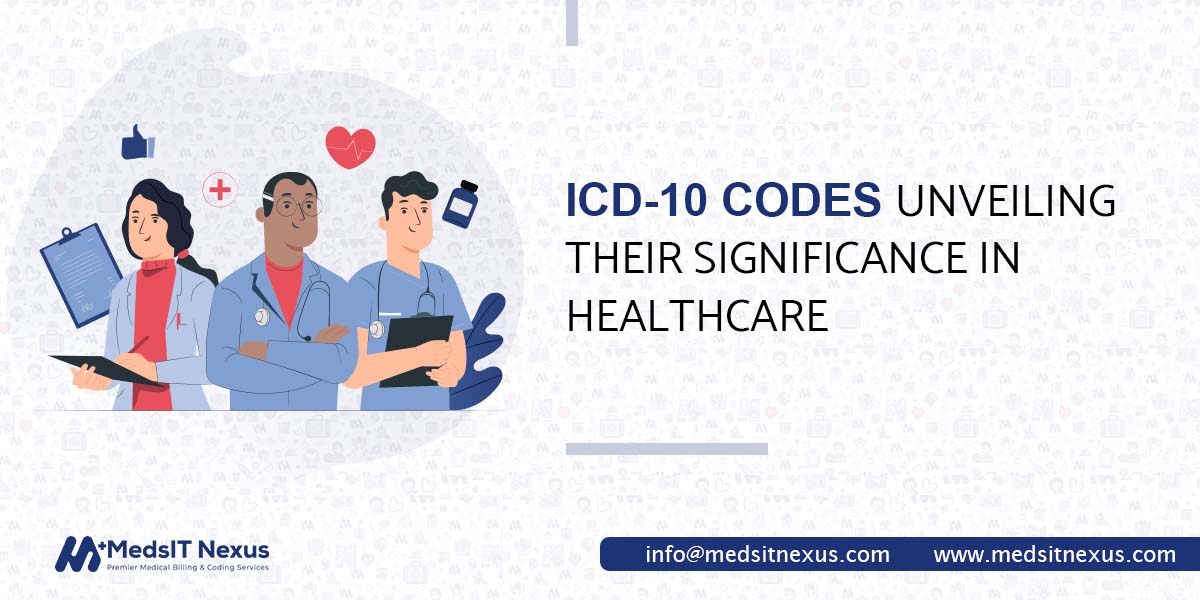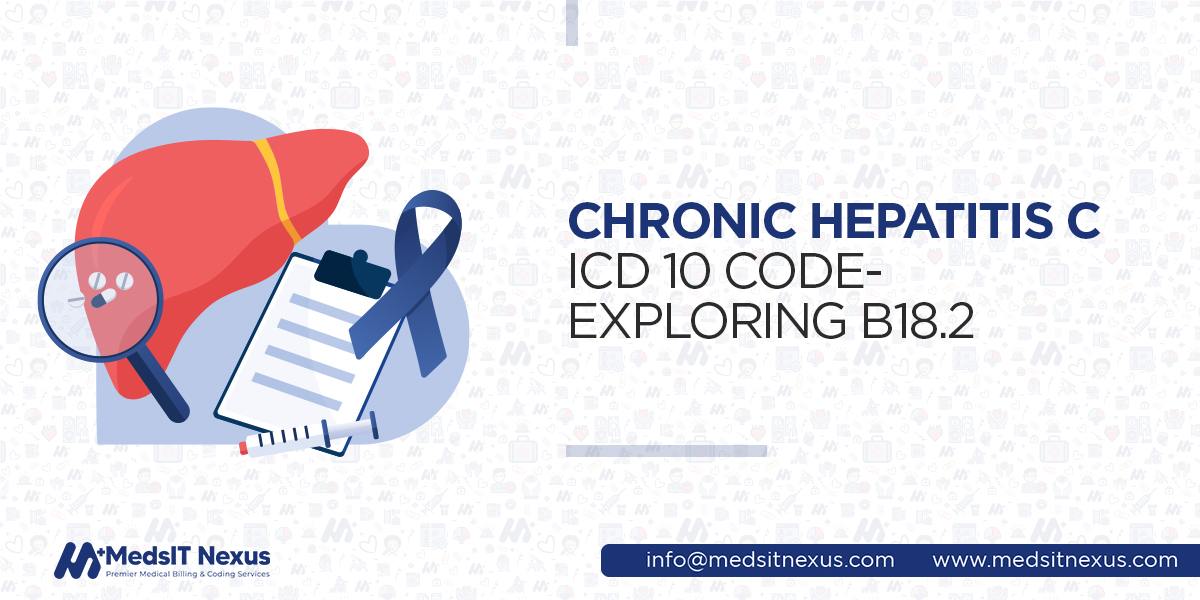ICD-10 Codes: Unveiling Their Significance In Healthcare

Transition and Development in the International Classification of Diseases (ICD) system have remained
constant since the scientific understanding of disease and the rise in exploring new areas and aspects
of the same medical condition through healthcare research increased over time in the healthcare domain.
Hence, adapting to the novel structures of diseases and medical operations, the WHO has implemented
several significant changes in the content and design of ICD codes over the past decades to improve the
extensibility and use of healthcare practice. The examples of modifications to ICD included
ICD-10-Clinical
Modification (ICD-10-CM), ICD-10 Procedure Coding System (ICD-10-PCS), and
country-specific modifications, which extend the specificity of ICD-10 to new needs, including
reimbursement and surveillance. The US adopted this modification on October 1, 2015, with strengths and
weaknesses. These changes and alterations require organizations worldwide to embrace significant changes
in the information and processes that use the ICD-10 coding system. However, the significance expands in
the innovative era of health
information technology that specifically adopts the ICD coding.
Healthcare providers ensure keeping up-to-date with each detail of the revisions in ICD Codes to
establish appropriate documentation of specific diagnoses and codes specifically for DRGs to boost the
entire healthcare practice's efficiency and revenue. Wrong Coding will lead to limited data and
ultimately to claim submission issues and denials. One of the examples of 10th version codes is ICD
Codes is B35.3 ICD-10-CM Code for Tinea Pedis, a converted form of ICD-9-CM Diagnosis 110.4. MedsIT
Nexus dedicatedly offers the appropriate ICD-10 Medical Coding services that
your practice needs. Stay
with us to follow the long-term benefits of ICD-10 Coding in this guide and ensure the practice's
success and potential reimbursement for the services offered.
Understanding International Classification Diseases (ICD) System
The International Classification of Diseases (ICD) is an international disease classification method
implemented unitedly across healthcare and was developed by the World Health Organization WHO in 1983.
The system classifies diseases according to their pathology, etiology, clinical manifestation, and
anatomical location in a systematic structure using specific codes to represent a disease or condition.
Healthcare provider's assigning appropriate ICD codes to patient medical documentation is called ICD
coding. The purpose of implementing the system is to standardize medical data and form the data basis
for intelligent medicine operations in healthcare.
ICD taxonomy also builds the basis for the Diagnosis-related
Groups (DRGs) payment system. Wrong Coding,
coding omissions, or multiple Coding directly affects the data quality used for DRGs. Hence, the loss is
inevitable that is caused by such coding errors by healthcare providers. According to the statistics
from the Centre of Medicare and Medicaid, the error payout rate was 6.8% in 2000, and the cause of these
errors was incorrect ICD coding assignment. Another survey report highlighted that the cost of
correcting wrong codes of ICD-9-CM could reach US $25 billion per year. Therefore, the significance of
ICD Coding is essential in medical practice as it influences the efficiency of medical record
management, reducing DRG cost and minimizing loss in medical payments.
What exactly are ICD-10 Codes, and who uses these Codes?
ICD refers to the International Classification of Disease, and 10 indicates the 10th version of these
codes authored by the World Health Organization WHO. These are alphanumeric codes that healthcare
agencies, doctors, and healthcare consulting firms use to represent a diagnosis across the globe. Every
disease, symptom, or injury has a specific code in the system, and the practitioners ought to report the
condition based on these codes.
The ICD Coding system is a standard way to compare and share medical data consistently over some time.
The US Department of Health and Human Services instructs that all Health Insurance Portability and
Accountability Act (HIPAA) comply with ICD-10 Codes.
The users of this coding system include nurses, physicians, providers, researchers, health information
managers and coders, health information technology workers, insurance and patient organizations, and
policymakers.
Used by all member states, the ICD Coding has been translated into 43 languages. However, the majority
of these countries implement Coding to report mortality data and primary indicators of health status.
Why does the authorization keep modifying the versions of ICD-10 Codes?
Because healthcare needs to keep changing, the authorities evolve the ICD Coding system to fulfill the
changing needs related to patient conditions and payment procedures. Up until 2015, the US healthcare
practice has used 1CD-9 since 1979. However, the system has outdated terms; some codes must be updated
to represent modern medical conditions. Hence, providing limited data on patient medical conditions and
a restricted number of regulations were among the significant causes of modification into the system.
Practitioners need to follow the changes to avoid the hassle of providing limited or incorrect patient
information to providers. According to the 1967 World Health Assembly's adoption of the WHO Nomenclature
Regulations, all Member States must report mortality and disease statistics using the most
recent
edition of the ICD.
One of the studies conducted in 2020 on the US adoption of ICD-10 codes with modifications
(ICD-10-CM/PCS) reports the impact on several areas in healthcare, including productivity and staffing,
costs, reimbursement, coding accuracy, mapping between ICD versions, morbidity and mortality
surveillance, and patient care. Although the study does not provide comprehensive evidence of the impact
of previous literature on ICD Codes in these areas, the survey reports describe a change in the
provider/coder's overall productivity after the implementation of ICD-10-CM/PCS. For example, according
to a CIOX/University of Pittsburgh analysis of the average ICD-10 coding time for 157 248 inpatient
records, rates were still 20% below productivity levels when compared to an earlier ICD-9 CIOX dataset
of 84 627 papers and 50% below American Health
Information Management Association (AHIMA) recommended
ICD-9 productivity levels, even though the average coding time improved from October 2015 (43.7
min/record) to February 2016 (40.4 min/record).
Differences Between ICD-9 and ICD-10 Codes Versions
The essential differences between the ICD-9 and ICD-10 coding are based on their size, laterality, and
expandability. Healthcare providers use ICD-Code B37.9 as an “unspecified” billable code for diagnosing
Candidiasis when the exact laterality isn’t identified in the patient medical record.
The alphanumeric ICD-10 codes consist 3-7 characters where the addition represents the disease in more
detail. The added characters represent laterality, listing of infectious body parts, approach, the
divide used, and essential qualifiers. ICD-10 Code R94.31 is one of
those example diagnosis codes
denoting “electrocardiograph” a diagnosis test to assess the heart’s electrical activity.
| ICD-9 | ICD-10 | |
|---|---|---|
| Specificity | In ICD-9, disease-specific identification is not possible. | ICD-10 codes let you specify a disease's etiology, anatomic site, severity, and initial manifestation. The example code is B95.61 for Methicillin Susceptible Staphylococcus Aureus Infection symbolizing mild skin conditions to severe bloodstream infections. |
| Size | There are over 13,000 diagnosis codes in ICD-9, all of which are numerical. | Approximately 68000 alphanumeric diagnosis codes make up ICD-10, which contains five times as many diagnosis codes and 19 times as many procedure codes as ICD-9. |
| Laterality | ICD-9 does not allow for laterality or the affected area or body part to be specified. | The new coding practice to improve specificity is called laterality. Documentation for the side/region of the body with designated codes is needed. |
| Terminology | ICD-9 refers to several diseases using outdated terminology. | ICD-10 nomenclature has been revised to match contemporary usage. |
| Expandability | Since ICD-9 was published approximately 40 years ago, new technology or diagnoses cannot be added. | ICD-10 allows for the addition of new diagnostic techniques as they are developed and new diseases as they appear. |
| Combination Codes | There was no provision for combination codes in ICD-9. | Combination codes in ICD-10 allow for coding numerous diagnoses under a single code. The example is Code B35.1 in ICD-10 Classification. |
As mentioned, some of the ICD-10 Codes will help you observe the coding specifications and complex classification under the 10th version of ICD Coding. Whereas, Some of the codes in ICD-10 include the details of disease’s severity like Code b19.20, used to diagnose unspecified viral Hepatitis C without Hepatic Coma.
Some of the Examples Of ICD-10 Codes Include:
As mentioned, some of the ICD-10 Codes will help you observe the Coding specifications and complex classification under the 10th version of ICD Coding.
The Valid Benefits are:
- Enhancing diagnosis code accuracy
- Presenting current disease classifications and medical terminology
- Supporting payment schemes that reward physicians for complicated problems
- Supplying more outstanding data for the analysis of illness patterns
- Enhancing the effectiveness of payments
- Avoiding errors
- Improving the healthcare sector's overall effectiveness
The Significance of ICD-10 Coding in Healthcare
ICD-10 codes have been a massive change in the US Healthcare that they have been following for almost 40 years. Offering a few challenges to the practitioners gave them long-term benefits with current medical terms. Implementing the new version included patient transparency, better provider communication, and streamlined the entire organization's workflow.
Improved Quality Care and Prefered Clinical Documentation
ICD-10 Coding has the potential to provide complete and accurate medical information on patient conditions. The system ensures the stage of care, specific diagnosis, laterality, and specific anatomy to clarify the patient's condition so the providers can efficiently allocate the required maintenance and resources for better outcomes.
Greater efficiency
Applying ICD-10 Coding helps providers generate great amounts of data and reserve it to improve public health. Government and healthcare officials can compare the practice with the international community by tracking and responding to global health threats. Moreover, injury research and trauma service evaluation can improve the classification of injuries and correlate them with the proper treatment, cause, and improvement.
Lesser Opportunities for Frauds
ICD-10 Coding also allows providers to avoid everyday fraudulent activities related to exaggerated claims and improve the payment for services delivered to patients. Healthcare practitioners can ensure quality patient care and enhance revenue for the organization by following ICD-10 Coding effectively.
Improved Healthcare Quality
The primary goal of ICD-9 was to increase reimbursements. But rather than focusing on returns, the ICD-10 coding structure offers a performance-based payment system. This will alter how healthcare is delivered and raise the standard of care overall.
Performance Monitoring
The transition to ICD-10 will enhance a provider's capacity to track services and resource use, assess healthcare expenditures, keep tabs on results, and gauge performance. Providers will be able to evaluate their performance compared to their peers and take the required actions to improve with more information on the different procedure types.
Data Improvement for Research
This specialization is useful for research as well. ICD-10 codes assist in revealing previously undiscovered connections between medical problems, aid in preserving numerous lives, and minimize the cost of medical care by billions. ICD-10 regulations improve data collection on side effects and result evaluation reporting in clinical research trials.
Improve your Practice Efficiency With MedsIT Nexus Accurate Medical Coding Solutions
ICD-10 Coding is an indispensable tool in the intricate web of physical medicine. They facilitate precise diagnosis, streamline billing, drive informed decision-making, and advance research and public health efforts. In the revolutionizing world of healthcare,MedsIT Nexus medical billing and coding services commit accuracy, efficacy, and above all the well-being of your patients with these codes. As we continue to unveil the significance of ICD-10 Codes in physical medicine, we reaffirm their enduring importance in pursuing optimal patient care and increased revenue.
Our qualified team of medical coding specialists is potentially trained and well-versed in the advances of ICD-10 Codes. Whether your practice searches for inpatient or outpatient coding or is in the final years of ICD-10 Coding and impending transition to ICD-11, our practice understands how best to use codes and each round of changes to get timely payments and reduce rejections. Moreover, our automated EHR/EMR Software solutions will transparently automate your billing process with innovative coding updates.
Samuel White, MBA-HC, CPAR -
Lead Author & Senior Healthcare Revenue Cycle Strategist at MedsIT Nexus
Leads editorial process for the publication of Technical RCM guides, reimbursement optimization case studies, and compliance-focused research content, expert evaluations of RCM software and medical billing solutions.






